Analyzing Homelessness Using Kingdon's Framework
VerifiedAdded on 2023/03/29
|12
|3145
|116
AI Summary
This article analyzes the issue of homelessness in Australia using Kingdon's framework. It discusses the causes of homelessness, government policies, and implementation strategies.
Contribute Materials
Your contribution can guide someone’s learning journey. Share your
documents today.
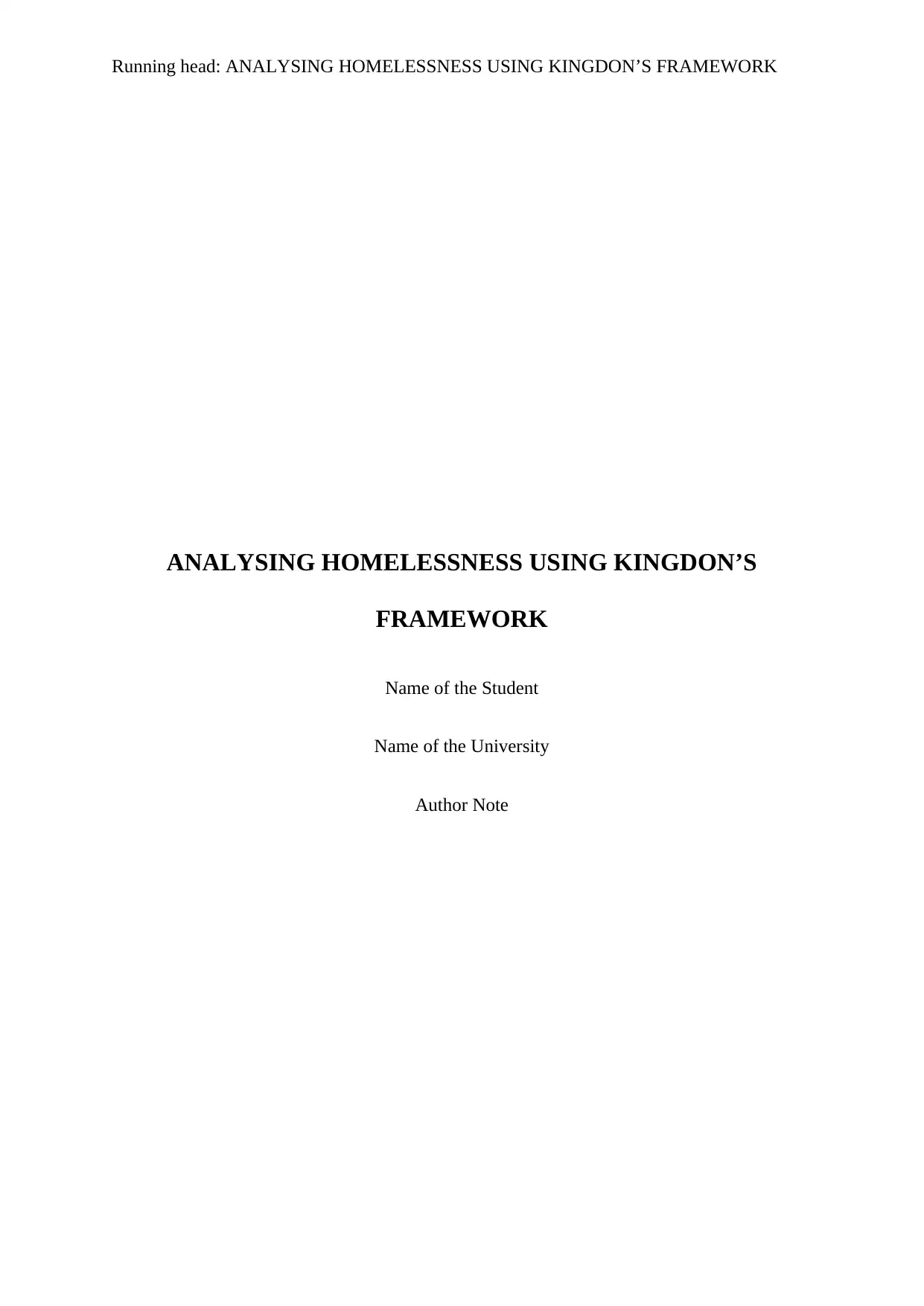
Running head: ANALYSING HOMELESSNESS USING KINGDON’S FRAMEWORK
ANALYSING HOMELESSNESS USING KINGDON’S
FRAMEWORK
Name of the Student
Name of the University
Author Note
ANALYSING HOMELESSNESS USING KINGDON’S
FRAMEWORK
Name of the Student
Name of the University
Author Note
Secure Best Marks with AI Grader
Need help grading? Try our AI Grader for instant feedback on your assignments.
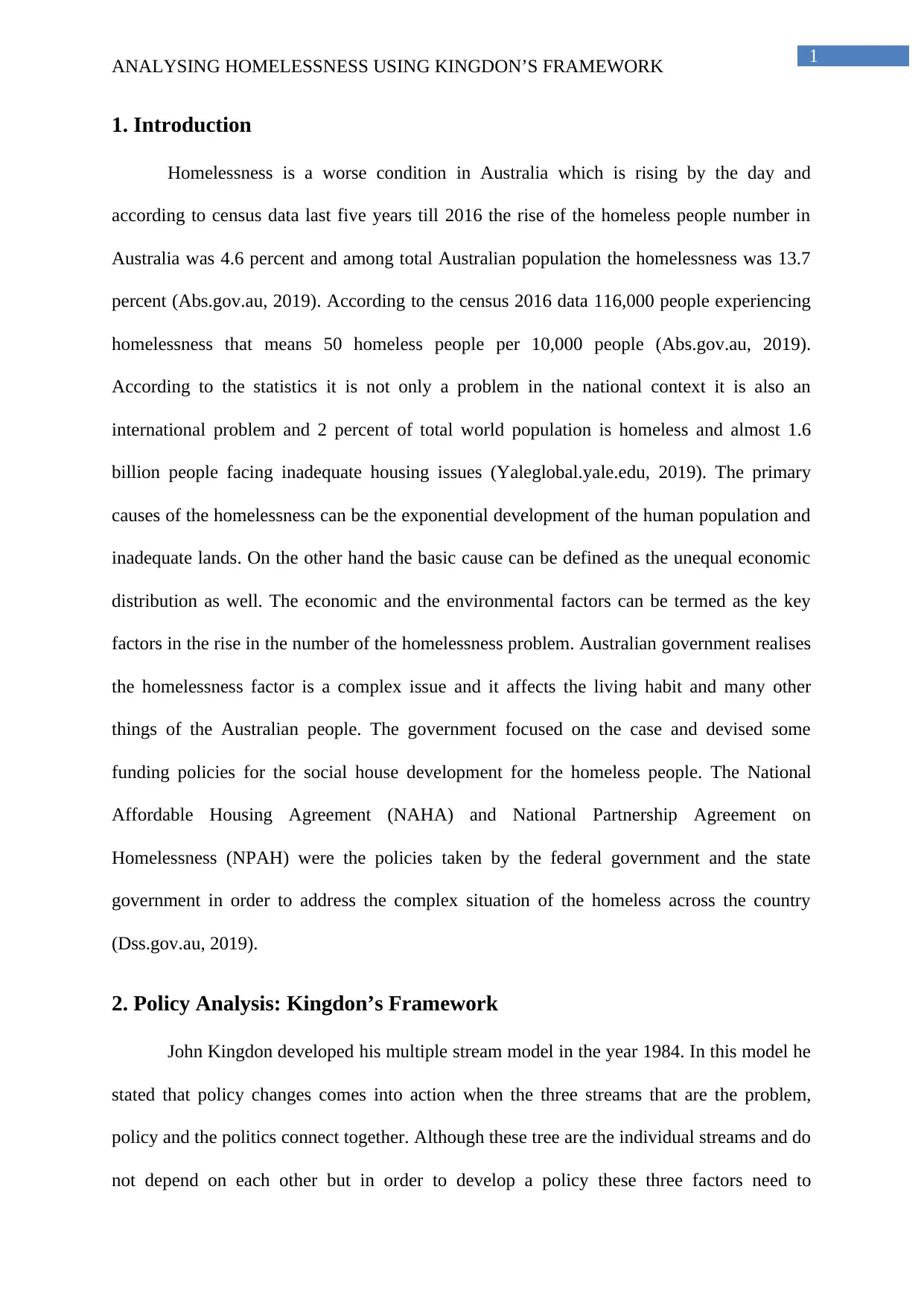
1
ANALYSING HOMELESSNESS USING KINGDON’S FRAMEWORK
1. Introduction
Homelessness is a worse condition in Australia which is rising by the day and
according to census data last five years till 2016 the rise of the homeless people number in
Australia was 4.6 percent and among total Australian population the homelessness was 13.7
percent (Abs.gov.au, 2019). According to the census 2016 data 116,000 people experiencing
homelessness that means 50 homeless people per 10,000 people (Abs.gov.au, 2019).
According to the statistics it is not only a problem in the national context it is also an
international problem and 2 percent of total world population is homeless and almost 1.6
billion people facing inadequate housing issues (Yaleglobal.yale.edu, 2019). The primary
causes of the homelessness can be the exponential development of the human population and
inadequate lands. On the other hand the basic cause can be defined as the unequal economic
distribution as well. The economic and the environmental factors can be termed as the key
factors in the rise in the number of the homelessness problem. Australian government realises
the homelessness factor is a complex issue and it affects the living habit and many other
things of the Australian people. The government focused on the case and devised some
funding policies for the social house development for the homeless people. The National
Affordable Housing Agreement (NAHA) and National Partnership Agreement on
Homelessness (NPAH) were the policies taken by the federal government and the state
government in order to address the complex situation of the homeless across the country
(Dss.gov.au, 2019).
2. Policy Analysis: Kingdon’s Framework
John Kingdon developed his multiple stream model in the year 1984. In this model he
stated that policy changes comes into action when the three streams that are the problem,
policy and the politics connect together. Although these tree are the individual streams and do
not depend on each other but in order to develop a policy these three factors need to
ANALYSING HOMELESSNESS USING KINGDON’S FRAMEWORK
1. Introduction
Homelessness is a worse condition in Australia which is rising by the day and
according to census data last five years till 2016 the rise of the homeless people number in
Australia was 4.6 percent and among total Australian population the homelessness was 13.7
percent (Abs.gov.au, 2019). According to the census 2016 data 116,000 people experiencing
homelessness that means 50 homeless people per 10,000 people (Abs.gov.au, 2019).
According to the statistics it is not only a problem in the national context it is also an
international problem and 2 percent of total world population is homeless and almost 1.6
billion people facing inadequate housing issues (Yaleglobal.yale.edu, 2019). The primary
causes of the homelessness can be the exponential development of the human population and
inadequate lands. On the other hand the basic cause can be defined as the unequal economic
distribution as well. The economic and the environmental factors can be termed as the key
factors in the rise in the number of the homelessness problem. Australian government realises
the homelessness factor is a complex issue and it affects the living habit and many other
things of the Australian people. The government focused on the case and devised some
funding policies for the social house development for the homeless people. The National
Affordable Housing Agreement (NAHA) and National Partnership Agreement on
Homelessness (NPAH) were the policies taken by the federal government and the state
government in order to address the complex situation of the homeless across the country
(Dss.gov.au, 2019).
2. Policy Analysis: Kingdon’s Framework
John Kingdon developed his multiple stream model in the year 1984. In this model he
stated that policy changes comes into action when the three streams that are the problem,
policy and the politics connect together. Although these tree are the individual streams and do
not depend on each other but in order to develop a policy these three factors need to
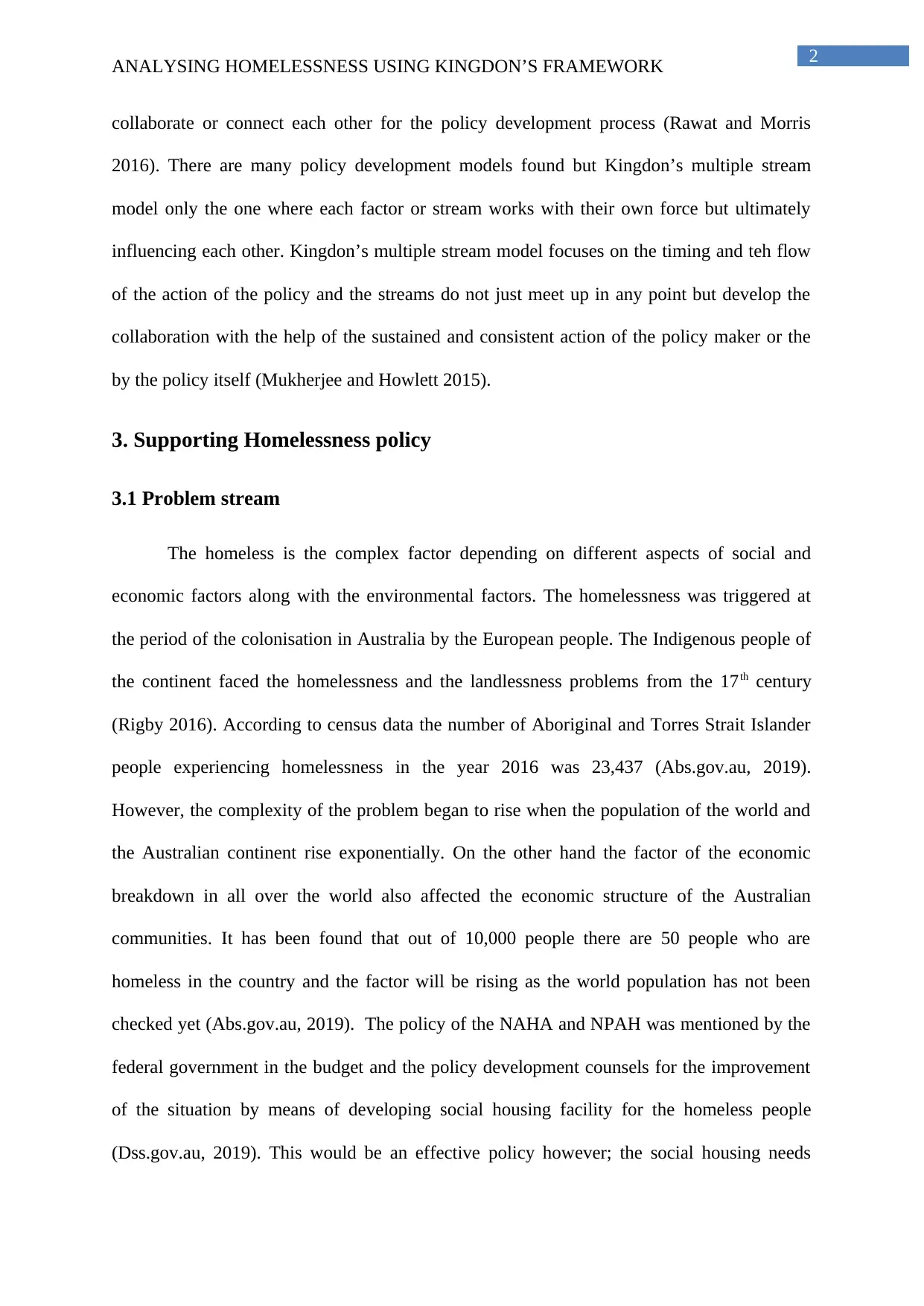
2
ANALYSING HOMELESSNESS USING KINGDON’S FRAMEWORK
collaborate or connect each other for the policy development process (Rawat and Morris
2016). There are many policy development models found but Kingdon’s multiple stream
model only the one where each factor or stream works with their own force but ultimately
influencing each other. Kingdon’s multiple stream model focuses on the timing and teh flow
of the action of the policy and the streams do not just meet up in any point but develop the
collaboration with the help of the sustained and consistent action of the policy maker or the
by the policy itself (Mukherjee and Howlett 2015).
3. Supporting Homelessness policy
3.1 Problem stream
The homeless is the complex factor depending on different aspects of social and
economic factors along with the environmental factors. The homelessness was triggered at
the period of the colonisation in Australia by the European people. The Indigenous people of
the continent faced the homelessness and the landlessness problems from the 17th century
(Rigby 2016). According to census data the number of Aboriginal and Torres Strait Islander
people experiencing homelessness in the year 2016 was 23,437 (Abs.gov.au, 2019).
However, the complexity of the problem began to rise when the population of the world and
the Australian continent rise exponentially. On the other hand the factor of the economic
breakdown in all over the world also affected the economic structure of the Australian
communities. It has been found that out of 10,000 people there are 50 people who are
homeless in the country and the factor will be rising as the world population has not been
checked yet (Abs.gov.au, 2019). The policy of the NAHA and NPAH was mentioned by the
federal government in the budget and the policy development counsels for the improvement
of the situation by means of developing social housing facility for the homeless people
(Dss.gov.au, 2019). This would be an effective policy however; the social housing needs
ANALYSING HOMELESSNESS USING KINGDON’S FRAMEWORK
collaborate or connect each other for the policy development process (Rawat and Morris
2016). There are many policy development models found but Kingdon’s multiple stream
model only the one where each factor or stream works with their own force but ultimately
influencing each other. Kingdon’s multiple stream model focuses on the timing and teh flow
of the action of the policy and the streams do not just meet up in any point but develop the
collaboration with the help of the sustained and consistent action of the policy maker or the
by the policy itself (Mukherjee and Howlett 2015).
3. Supporting Homelessness policy
3.1 Problem stream
The homeless is the complex factor depending on different aspects of social and
economic factors along with the environmental factors. The homelessness was triggered at
the period of the colonisation in Australia by the European people. The Indigenous people of
the continent faced the homelessness and the landlessness problems from the 17th century
(Rigby 2016). According to census data the number of Aboriginal and Torres Strait Islander
people experiencing homelessness in the year 2016 was 23,437 (Abs.gov.au, 2019).
However, the complexity of the problem began to rise when the population of the world and
the Australian continent rise exponentially. On the other hand the factor of the economic
breakdown in all over the world also affected the economic structure of the Australian
communities. It has been found that out of 10,000 people there are 50 people who are
homeless in the country and the factor will be rising as the world population has not been
checked yet (Abs.gov.au, 2019). The policy of the NAHA and NPAH was mentioned by the
federal government in the budget and the policy development counsels for the improvement
of the situation by means of developing social housing facility for the homeless people
(Dss.gov.au, 2019). This would be an effective policy however; the social housing needs

3
ANALYSING HOMELESSNESS USING KINGDON’S FRAMEWORK
lands that can be an issue needed to be considered first along with the funding for the project.
According to Kingdon’s multiple stream model the data collection is fairly important for the
knowledge of the problem however, the problem cannot be addressed without the
interpretation of the data (Howlett, McConnell and Perl 2017). According to the data it can be
seen there are 116,427 people are facing the problem of homelessness in the country and the
change of the issue raised in five years up to 13.7 percent (Abs.gov.au, 2019). This condition
needs to be addressed by the government with the developed policies and also
implementation of other policies in order to provide a safe and healthy living to the country
people.
3.2 Policy stream
In terms of addressing homelessness in the Australian context there have been
different policies suggested by the government on the basis of the census report of homeless
population. The primary focus of these policies are funding for the social housing facilities.
The NAHA and NPAH policies are the policies among these policies which were recently
been identified for addressing the issue. In the budget year 2017-2018 government has been
working on the reformation of these two above mentioned policies and the formation of the
National Housing and Homeless Agreement (NHHA) policy for the betterment in addressing
the homelessness issue (Dss.gov.au, 2019). They were convinced in the fact that the NHHA
policy would be helpful in the increasing number of the new home supply and the
improvement of the housing condition for the Australian people especially whom are in need.
According to government announcement the NHHA policy will be providing $375.3 million
for three years starting from July 2018 (Dss.gov.au, 2019). The funding will be focused on
the domestic violence cases and it will help especially the young vulnerable population. They
also stated that the Transitional National Partnership Agreement on Homelessness policy will
provide $117.2 million to the homeless people prior to the effectiveness of the NHHA policy
ANALYSING HOMELESSNESS USING KINGDON’S FRAMEWORK
lands that can be an issue needed to be considered first along with the funding for the project.
According to Kingdon’s multiple stream model the data collection is fairly important for the
knowledge of the problem however, the problem cannot be addressed without the
interpretation of the data (Howlett, McConnell and Perl 2017). According to the data it can be
seen there are 116,427 people are facing the problem of homelessness in the country and the
change of the issue raised in five years up to 13.7 percent (Abs.gov.au, 2019). This condition
needs to be addressed by the government with the developed policies and also
implementation of other policies in order to provide a safe and healthy living to the country
people.
3.2 Policy stream
In terms of addressing homelessness in the Australian context there have been
different policies suggested by the government on the basis of the census report of homeless
population. The primary focus of these policies are funding for the social housing facilities.
The NAHA and NPAH policies are the policies among these policies which were recently
been identified for addressing the issue. In the budget year 2017-2018 government has been
working on the reformation of these two above mentioned policies and the formation of the
National Housing and Homeless Agreement (NHHA) policy for the betterment in addressing
the homelessness issue (Dss.gov.au, 2019). They were convinced in the fact that the NHHA
policy would be helpful in the increasing number of the new home supply and the
improvement of the housing condition for the Australian people especially whom are in need.
According to government announcement the NHHA policy will be providing $375.3 million
for three years starting from July 2018 (Dss.gov.au, 2019). The funding will be focused on
the domestic violence cases and it will help especially the young vulnerable population. They
also stated that the Transitional National Partnership Agreement on Homelessness policy will
provide $117.2 million to the homeless people prior to the effectiveness of the NHHA policy
Secure Best Marks with AI Grader
Need help grading? Try our AI Grader for instant feedback on your assignments.
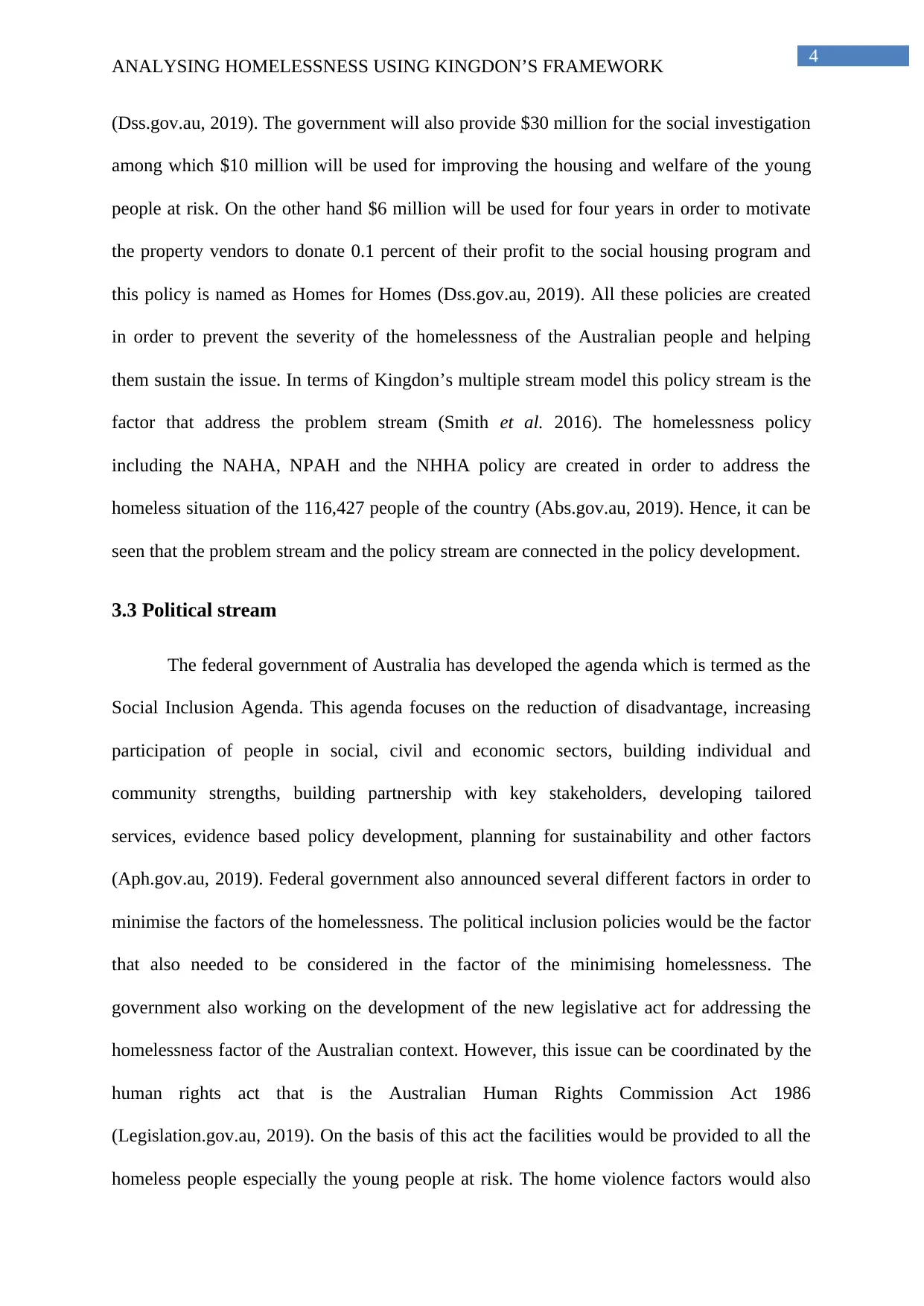
4
ANALYSING HOMELESSNESS USING KINGDON’S FRAMEWORK
(Dss.gov.au, 2019). The government will also provide $30 million for the social investigation
among which $10 million will be used for improving the housing and welfare of the young
people at risk. On the other hand $6 million will be used for four years in order to motivate
the property vendors to donate 0.1 percent of their profit to the social housing program and
this policy is named as Homes for Homes (Dss.gov.au, 2019). All these policies are created
in order to prevent the severity of the homelessness of the Australian people and helping
them sustain the issue. In terms of Kingdon’s multiple stream model this policy stream is the
factor that address the problem stream (Smith et al. 2016). The homelessness policy
including the NAHA, NPAH and the NHHA policy are created in order to address the
homeless situation of the 116,427 people of the country (Abs.gov.au, 2019). Hence, it can be
seen that the problem stream and the policy stream are connected in the policy development.
3.3 Political stream
The federal government of Australia has developed the agenda which is termed as the
Social Inclusion Agenda. This agenda focuses on the reduction of disadvantage, increasing
participation of people in social, civil and economic sectors, building individual and
community strengths, building partnership with key stakeholders, developing tailored
services, evidence based policy development, planning for sustainability and other factors
(Aph.gov.au, 2019). Federal government also announced several different factors in order to
minimise the factors of the homelessness. The political inclusion policies would be the factor
that also needed to be considered in the factor of the minimising homelessness. The
government also working on the development of the new legislative act for addressing the
homelessness factor of the Australian context. However, this issue can be coordinated by the
human rights act that is the Australian Human Rights Commission Act 1986
(Legislation.gov.au, 2019). On the basis of this act the facilities would be provided to all the
homeless people especially the young people at risk. The home violence factors would also
ANALYSING HOMELESSNESS USING KINGDON’S FRAMEWORK
(Dss.gov.au, 2019). The government will also provide $30 million for the social investigation
among which $10 million will be used for improving the housing and welfare of the young
people at risk. On the other hand $6 million will be used for four years in order to motivate
the property vendors to donate 0.1 percent of their profit to the social housing program and
this policy is named as Homes for Homes (Dss.gov.au, 2019). All these policies are created
in order to prevent the severity of the homelessness of the Australian people and helping
them sustain the issue. In terms of Kingdon’s multiple stream model this policy stream is the
factor that address the problem stream (Smith et al. 2016). The homelessness policy
including the NAHA, NPAH and the NHHA policy are created in order to address the
homeless situation of the 116,427 people of the country (Abs.gov.au, 2019). Hence, it can be
seen that the problem stream and the policy stream are connected in the policy development.
3.3 Political stream
The federal government of Australia has developed the agenda which is termed as the
Social Inclusion Agenda. This agenda focuses on the reduction of disadvantage, increasing
participation of people in social, civil and economic sectors, building individual and
community strengths, building partnership with key stakeholders, developing tailored
services, evidence based policy development, planning for sustainability and other factors
(Aph.gov.au, 2019). Federal government also announced several different factors in order to
minimise the factors of the homelessness. The political inclusion policies would be the factor
that also needed to be considered in the factor of the minimising homelessness. The
government also working on the development of the new legislative act for addressing the
homelessness factor of the Australian context. However, this issue can be coordinated by the
human rights act that is the Australian Human Rights Commission Act 1986
(Legislation.gov.au, 2019). On the basis of this act the facilities would be provided to all the
homeless people especially the young people at risk. The home violence factors would also
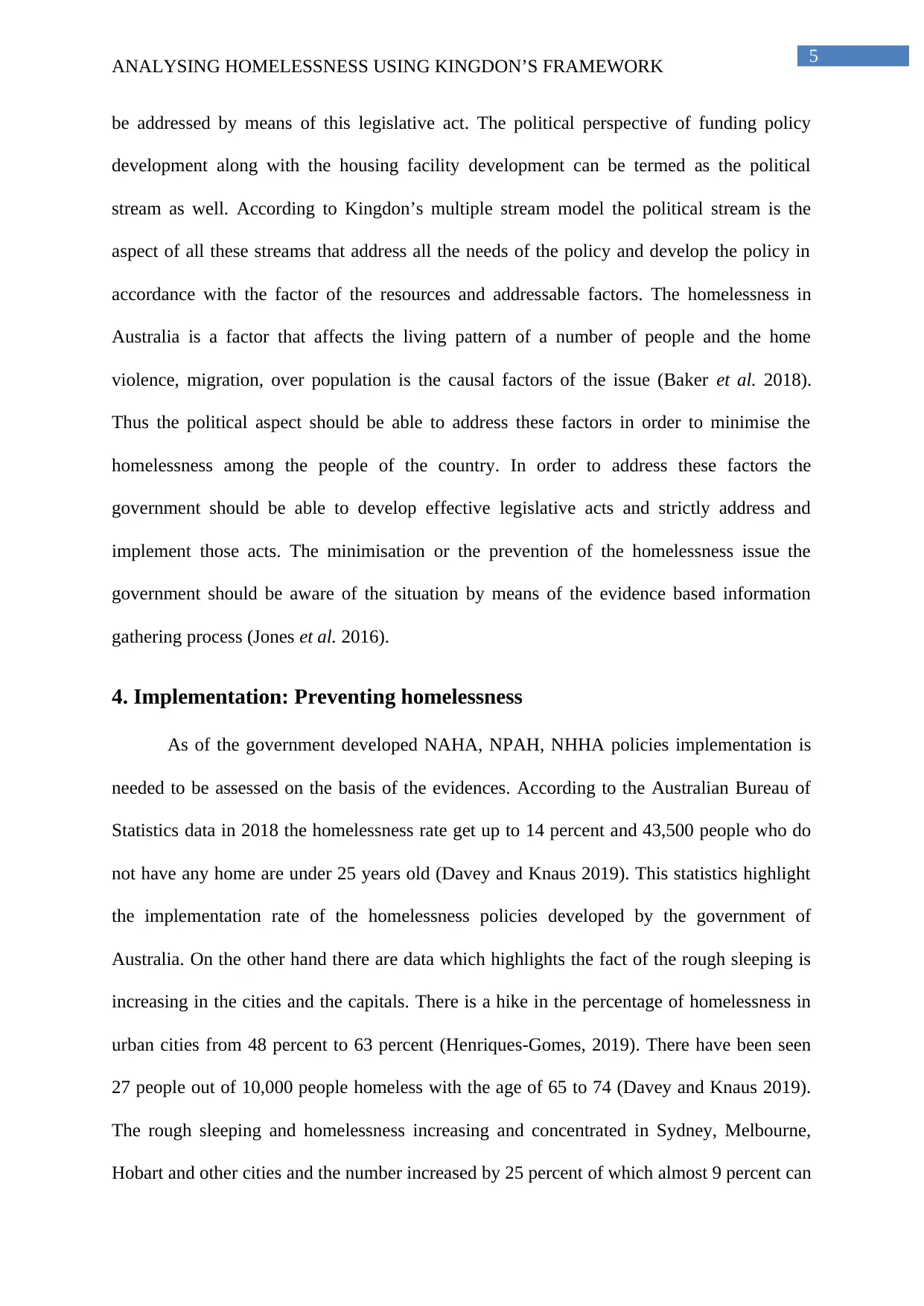
5
ANALYSING HOMELESSNESS USING KINGDON’S FRAMEWORK
be addressed by means of this legislative act. The political perspective of funding policy
development along with the housing facility development can be termed as the political
stream as well. According to Kingdon’s multiple stream model the political stream is the
aspect of all these streams that address all the needs of the policy and develop the policy in
accordance with the factor of the resources and addressable factors. The homelessness in
Australia is a factor that affects the living pattern of a number of people and the home
violence, migration, over population is the causal factors of the issue (Baker et al. 2018).
Thus the political aspect should be able to address these factors in order to minimise the
homelessness among the people of the country. In order to address these factors the
government should be able to develop effective legislative acts and strictly address and
implement those acts. The minimisation or the prevention of the homelessness issue the
government should be aware of the situation by means of the evidence based information
gathering process (Jones et al. 2016).
4. Implementation: Preventing homelessness
As of the government developed NAHA, NPAH, NHHA policies implementation is
needed to be assessed on the basis of the evidences. According to the Australian Bureau of
Statistics data in 2018 the homelessness rate get up to 14 percent and 43,500 people who do
not have any home are under 25 years old (Davey and Knaus 2019). This statistics highlight
the implementation rate of the homelessness policies developed by the government of
Australia. On the other hand there are data which highlights the fact of the rough sleeping is
increasing in the cities and the capitals. There is a hike in the percentage of homelessness in
urban cities from 48 percent to 63 percent (Henriques-Gomes, 2019). There have been seen
27 people out of 10,000 people homeless with the age of 65 to 74 (Davey and Knaus 2019).
The rough sleeping and homelessness increasing and concentrated in Sydney, Melbourne,
Hobart and other cities and the number increased by 25 percent of which almost 9 percent can
ANALYSING HOMELESSNESS USING KINGDON’S FRAMEWORK
be addressed by means of this legislative act. The political perspective of funding policy
development along with the housing facility development can be termed as the political
stream as well. According to Kingdon’s multiple stream model the political stream is the
aspect of all these streams that address all the needs of the policy and develop the policy in
accordance with the factor of the resources and addressable factors. The homelessness in
Australia is a factor that affects the living pattern of a number of people and the home
violence, migration, over population is the causal factors of the issue (Baker et al. 2018).
Thus the political aspect should be able to address these factors in order to minimise the
homelessness among the people of the country. In order to address these factors the
government should be able to develop effective legislative acts and strictly address and
implement those acts. The minimisation or the prevention of the homelessness issue the
government should be aware of the situation by means of the evidence based information
gathering process (Jones et al. 2016).
4. Implementation: Preventing homelessness
As of the government developed NAHA, NPAH, NHHA policies implementation is
needed to be assessed on the basis of the evidences. According to the Australian Bureau of
Statistics data in 2018 the homelessness rate get up to 14 percent and 43,500 people who do
not have any home are under 25 years old (Davey and Knaus 2019). This statistics highlight
the implementation rate of the homelessness policies developed by the government of
Australia. On the other hand there are data which highlights the fact of the rough sleeping is
increasing in the cities and the capitals. There is a hike in the percentage of homelessness in
urban cities from 48 percent to 63 percent (Henriques-Gomes, 2019). There have been seen
27 people out of 10,000 people homeless with the age of 65 to 74 (Davey and Knaus 2019).
The rough sleeping and homelessness increasing and concentrated in Sydney, Melbourne,
Hobart and other cities and the number increased by 25 percent of which almost 9 percent can
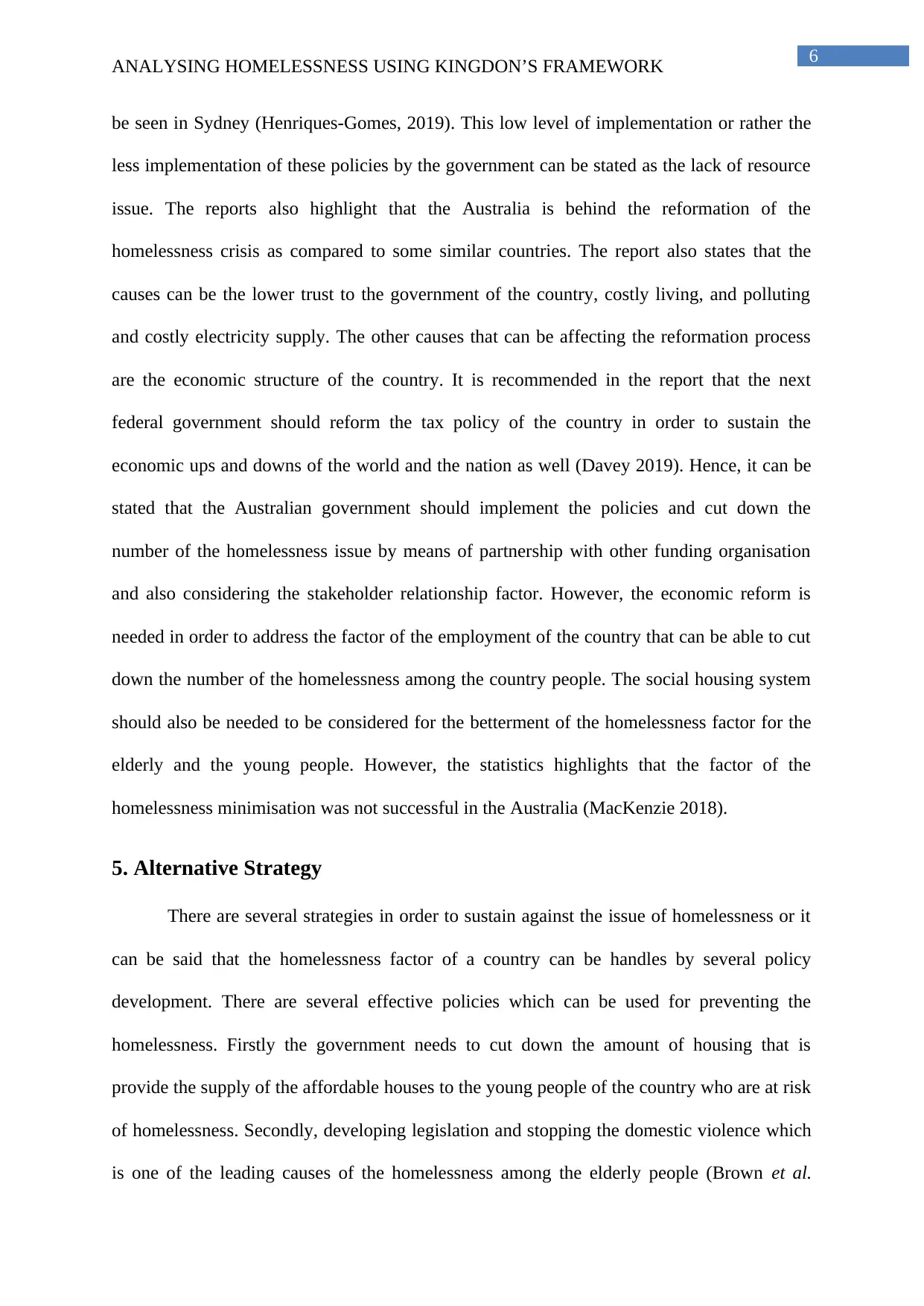
6
ANALYSING HOMELESSNESS USING KINGDON’S FRAMEWORK
be seen in Sydney (Henriques-Gomes, 2019). This low level of implementation or rather the
less implementation of these policies by the government can be stated as the lack of resource
issue. The reports also highlight that the Australia is behind the reformation of the
homelessness crisis as compared to some similar countries. The report also states that the
causes can be the lower trust to the government of the country, costly living, and polluting
and costly electricity supply. The other causes that can be affecting the reformation process
are the economic structure of the country. It is recommended in the report that the next
federal government should reform the tax policy of the country in order to sustain the
economic ups and downs of the world and the nation as well (Davey 2019). Hence, it can be
stated that the Australian government should implement the policies and cut down the
number of the homelessness issue by means of partnership with other funding organisation
and also considering the stakeholder relationship factor. However, the economic reform is
needed in order to address the factor of the employment of the country that can be able to cut
down the number of the homelessness among the country people. The social housing system
should also be needed to be considered for the betterment of the homelessness factor for the
elderly and the young people. However, the statistics highlights that the factor of the
homelessness minimisation was not successful in the Australia (MacKenzie 2018).
5. Alternative Strategy
There are several strategies in order to sustain against the issue of homelessness or it
can be said that the homelessness factor of a country can be handles by several policy
development. There are several effective policies which can be used for preventing the
homelessness. Firstly the government needs to cut down the amount of housing that is
provide the supply of the affordable houses to the young people of the country who are at risk
of homelessness. Secondly, developing legislation and stopping the domestic violence which
is one of the leading causes of the homelessness among the elderly people (Brown et al.
ANALYSING HOMELESSNESS USING KINGDON’S FRAMEWORK
be seen in Sydney (Henriques-Gomes, 2019). This low level of implementation or rather the
less implementation of these policies by the government can be stated as the lack of resource
issue. The reports also highlight that the Australia is behind the reformation of the
homelessness crisis as compared to some similar countries. The report also states that the
causes can be the lower trust to the government of the country, costly living, and polluting
and costly electricity supply. The other causes that can be affecting the reformation process
are the economic structure of the country. It is recommended in the report that the next
federal government should reform the tax policy of the country in order to sustain the
economic ups and downs of the world and the nation as well (Davey 2019). Hence, it can be
stated that the Australian government should implement the policies and cut down the
number of the homelessness issue by means of partnership with other funding organisation
and also considering the stakeholder relationship factor. However, the economic reform is
needed in order to address the factor of the employment of the country that can be able to cut
down the number of the homelessness among the country people. The social housing system
should also be needed to be considered for the betterment of the homelessness factor for the
elderly and the young people. However, the statistics highlights that the factor of the
homelessness minimisation was not successful in the Australia (MacKenzie 2018).
5. Alternative Strategy
There are several strategies in order to sustain against the issue of homelessness or it
can be said that the homelessness factor of a country can be handles by several policy
development. There are several effective policies which can be used for preventing the
homelessness. Firstly the government needs to cut down the amount of housing that is
provide the supply of the affordable houses to the young people of the country who are at risk
of homelessness. Secondly, developing legislation and stopping the domestic violence which
is one of the leading causes of the homelessness among the elderly people (Brown et al.
Paraphrase This Document
Need a fresh take? Get an instant paraphrase of this document with our AI Paraphraser
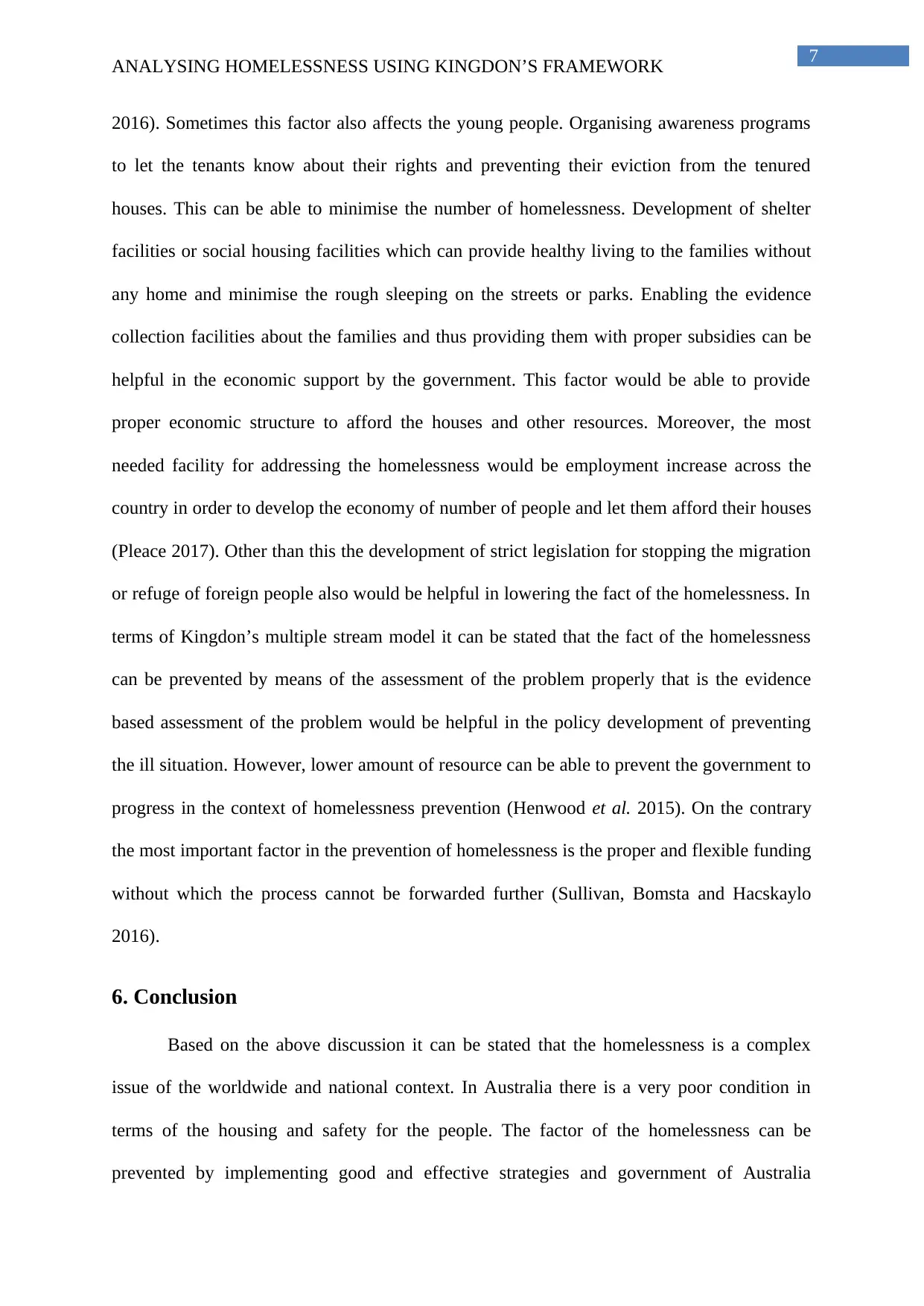
7
ANALYSING HOMELESSNESS USING KINGDON’S FRAMEWORK
2016). Sometimes this factor also affects the young people. Organising awareness programs
to let the tenants know about their rights and preventing their eviction from the tenured
houses. This can be able to minimise the number of homelessness. Development of shelter
facilities or social housing facilities which can provide healthy living to the families without
any home and minimise the rough sleeping on the streets or parks. Enabling the evidence
collection facilities about the families and thus providing them with proper subsidies can be
helpful in the economic support by the government. This factor would be able to provide
proper economic structure to afford the houses and other resources. Moreover, the most
needed facility for addressing the homelessness would be employment increase across the
country in order to develop the economy of number of people and let them afford their houses
(Pleace 2017). Other than this the development of strict legislation for stopping the migration
or refuge of foreign people also would be helpful in lowering the fact of the homelessness. In
terms of Kingdon’s multiple stream model it can be stated that the fact of the homelessness
can be prevented by means of the assessment of the problem properly that is the evidence
based assessment of the problem would be helpful in the policy development of preventing
the ill situation. However, lower amount of resource can be able to prevent the government to
progress in the context of homelessness prevention (Henwood et al. 2015). On the contrary
the most important factor in the prevention of homelessness is the proper and flexible funding
without which the process cannot be forwarded further (Sullivan, Bomsta and Hacskaylo
2016).
6. Conclusion
Based on the above discussion it can be stated that the homelessness is a complex
issue of the worldwide and national context. In Australia there is a very poor condition in
terms of the housing and safety for the people. The factor of the homelessness can be
prevented by implementing good and effective strategies and government of Australia
ANALYSING HOMELESSNESS USING KINGDON’S FRAMEWORK
2016). Sometimes this factor also affects the young people. Organising awareness programs
to let the tenants know about their rights and preventing their eviction from the tenured
houses. This can be able to minimise the number of homelessness. Development of shelter
facilities or social housing facilities which can provide healthy living to the families without
any home and minimise the rough sleeping on the streets or parks. Enabling the evidence
collection facilities about the families and thus providing them with proper subsidies can be
helpful in the economic support by the government. This factor would be able to provide
proper economic structure to afford the houses and other resources. Moreover, the most
needed facility for addressing the homelessness would be employment increase across the
country in order to develop the economy of number of people and let them afford their houses
(Pleace 2017). Other than this the development of strict legislation for stopping the migration
or refuge of foreign people also would be helpful in lowering the fact of the homelessness. In
terms of Kingdon’s multiple stream model it can be stated that the fact of the homelessness
can be prevented by means of the assessment of the problem properly that is the evidence
based assessment of the problem would be helpful in the policy development of preventing
the ill situation. However, lower amount of resource can be able to prevent the government to
progress in the context of homelessness prevention (Henwood et al. 2015). On the contrary
the most important factor in the prevention of homelessness is the proper and flexible funding
without which the process cannot be forwarded further (Sullivan, Bomsta and Hacskaylo
2016).
6. Conclusion
Based on the above discussion it can be stated that the homelessness is a complex
issue of the worldwide and national context. In Australia there is a very poor condition in
terms of the housing and safety for the people. The factor of the homelessness can be
prevented by implementing good and effective strategies and government of Australia
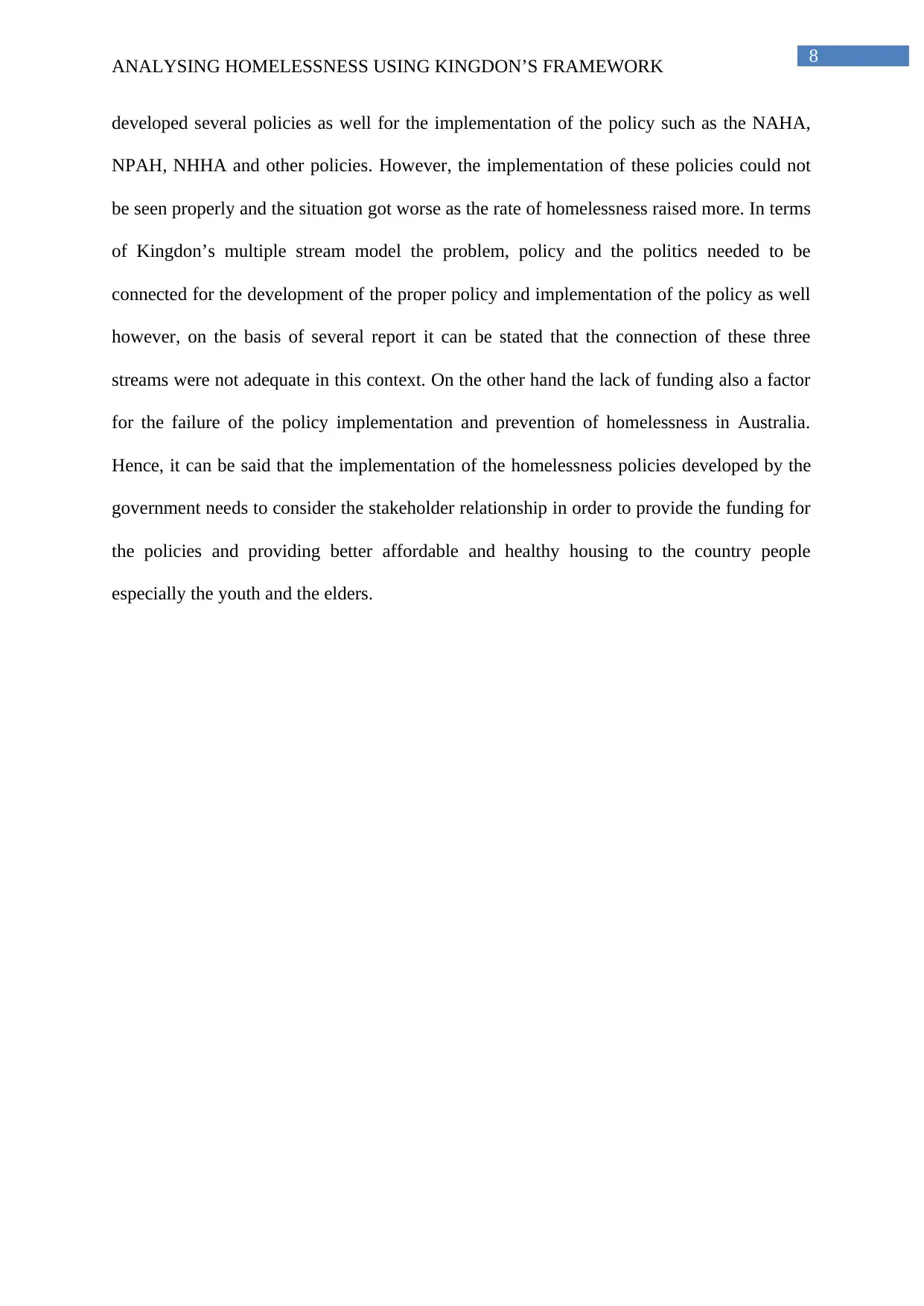
8
ANALYSING HOMELESSNESS USING KINGDON’S FRAMEWORK
developed several policies as well for the implementation of the policy such as the NAHA,
NPAH, NHHA and other policies. However, the implementation of these policies could not
be seen properly and the situation got worse as the rate of homelessness raised more. In terms
of Kingdon’s multiple stream model the problem, policy and the politics needed to be
connected for the development of the proper policy and implementation of the policy as well
however, on the basis of several report it can be stated that the connection of these three
streams were not adequate in this context. On the other hand the lack of funding also a factor
for the failure of the policy implementation and prevention of homelessness in Australia.
Hence, it can be said that the implementation of the homelessness policies developed by the
government needs to consider the stakeholder relationship in order to provide the funding for
the policies and providing better affordable and healthy housing to the country people
especially the youth and the elders.
ANALYSING HOMELESSNESS USING KINGDON’S FRAMEWORK
developed several policies as well for the implementation of the policy such as the NAHA,
NPAH, NHHA and other policies. However, the implementation of these policies could not
be seen properly and the situation got worse as the rate of homelessness raised more. In terms
of Kingdon’s multiple stream model the problem, policy and the politics needed to be
connected for the development of the proper policy and implementation of the policy as well
however, on the basis of several report it can be stated that the connection of these three
streams were not adequate in this context. On the other hand the lack of funding also a factor
for the failure of the policy implementation and prevention of homelessness in Australia.
Hence, it can be said that the implementation of the homelessness policies developed by the
government needs to consider the stakeholder relationship in order to provide the funding for
the policies and providing better affordable and healthy housing to the country people
especially the youth and the elders.
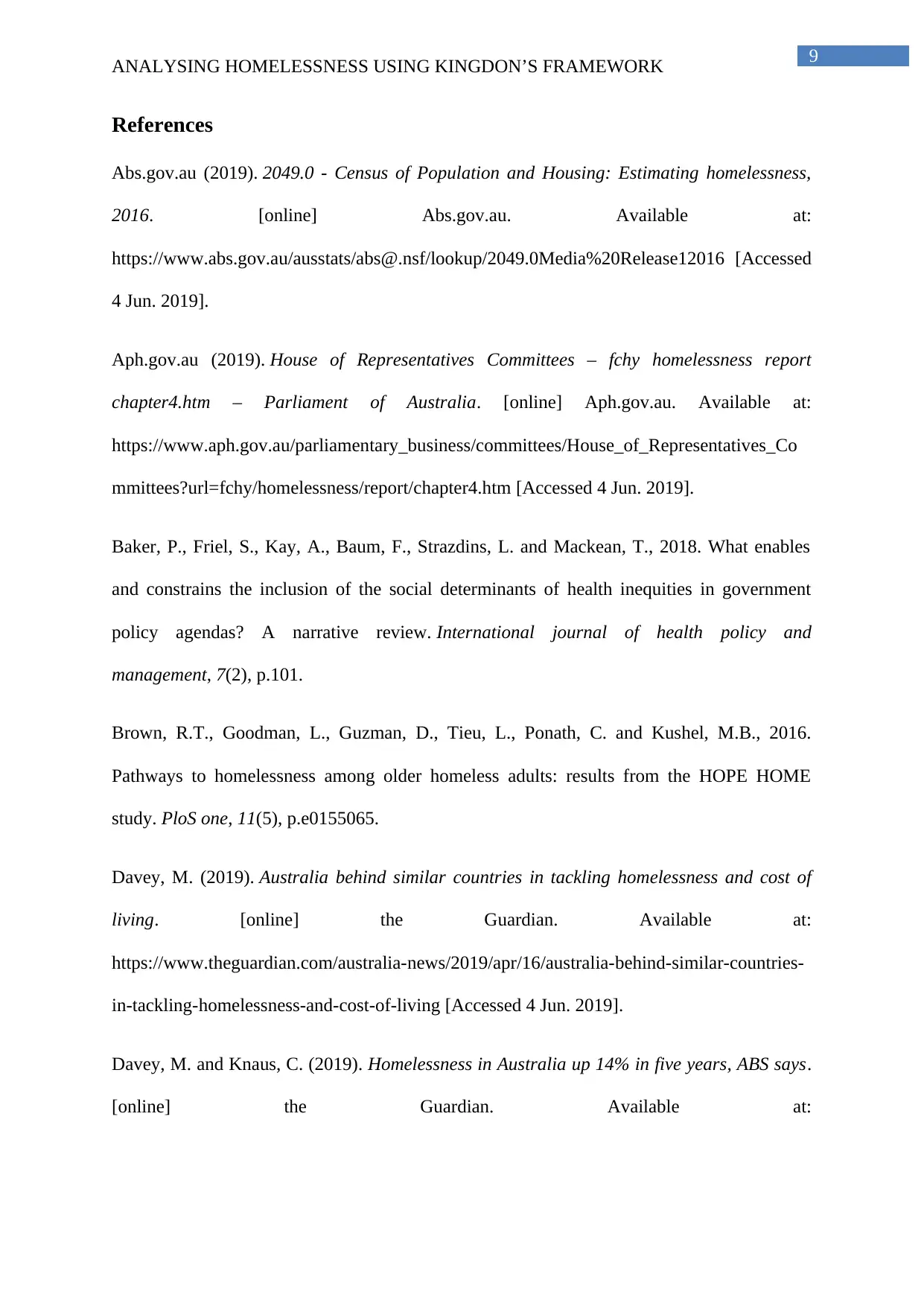
9
ANALYSING HOMELESSNESS USING KINGDON’S FRAMEWORK
References
Abs.gov.au (2019). 2049.0 - Census of Population and Housing: Estimating homelessness,
2016. [online] Abs.gov.au. Available at:
https://www.abs.gov.au/ausstats/abs@.nsf/lookup/2049.0Media%20Release12016 [Accessed
4 Jun. 2019].
Aph.gov.au (2019). House of Representatives Committees – fchy homelessness report
chapter4.htm – Parliament of Australia. [online] Aph.gov.au. Available at:
https://www.aph.gov.au/parliamentary_business/committees/House_of_Representatives_Co
mmittees?url=fchy/homelessness/report/chapter4.htm [Accessed 4 Jun. 2019].
Baker, P., Friel, S., Kay, A., Baum, F., Strazdins, L. and Mackean, T., 2018. What enables
and constrains the inclusion of the social determinants of health inequities in government
policy agendas? A narrative review. International journal of health policy and
management, 7(2), p.101.
Brown, R.T., Goodman, L., Guzman, D., Tieu, L., Ponath, C. and Kushel, M.B., 2016.
Pathways to homelessness among older homeless adults: results from the HOPE HOME
study. PloS one, 11(5), p.e0155065.
Davey, M. (2019). Australia behind similar countries in tackling homelessness and cost of
living. [online] the Guardian. Available at:
https://www.theguardian.com/australia-news/2019/apr/16/australia-behind-similar-countries-
in-tackling-homelessness-and-cost-of-living [Accessed 4 Jun. 2019].
Davey, M. and Knaus, C. (2019). Homelessness in Australia up 14% in five years, ABS says.
[online] the Guardian. Available at:
ANALYSING HOMELESSNESS USING KINGDON’S FRAMEWORK
References
Abs.gov.au (2019). 2049.0 - Census of Population and Housing: Estimating homelessness,
2016. [online] Abs.gov.au. Available at:
https://www.abs.gov.au/ausstats/abs@.nsf/lookup/2049.0Media%20Release12016 [Accessed
4 Jun. 2019].
Aph.gov.au (2019). House of Representatives Committees – fchy homelessness report
chapter4.htm – Parliament of Australia. [online] Aph.gov.au. Available at:
https://www.aph.gov.au/parliamentary_business/committees/House_of_Representatives_Co
mmittees?url=fchy/homelessness/report/chapter4.htm [Accessed 4 Jun. 2019].
Baker, P., Friel, S., Kay, A., Baum, F., Strazdins, L. and Mackean, T., 2018. What enables
and constrains the inclusion of the social determinants of health inequities in government
policy agendas? A narrative review. International journal of health policy and
management, 7(2), p.101.
Brown, R.T., Goodman, L., Guzman, D., Tieu, L., Ponath, C. and Kushel, M.B., 2016.
Pathways to homelessness among older homeless adults: results from the HOPE HOME
study. PloS one, 11(5), p.e0155065.
Davey, M. (2019). Australia behind similar countries in tackling homelessness and cost of
living. [online] the Guardian. Available at:
https://www.theguardian.com/australia-news/2019/apr/16/australia-behind-similar-countries-
in-tackling-homelessness-and-cost-of-living [Accessed 4 Jun. 2019].
Davey, M. and Knaus, C. (2019). Homelessness in Australia up 14% in five years, ABS says.
[online] the Guardian. Available at:
Secure Best Marks with AI Grader
Need help grading? Try our AI Grader for instant feedback on your assignments.

10
ANALYSING HOMELESSNESS USING KINGDON’S FRAMEWORK
https://www.theguardian.com/australia-news/2018/mar/14/homelessness-in-australia-up-14-
in-five-years-abs-says [Accessed 4 Jun. 2019].
Dss.gov.au (2019). Homelessness | Department of Social Services, Australian Government.
[online] Dss.gov.au. Available at: https://www.dss.gov.au/housing-support/programmes-
services/homelessness [Accessed 4 Jun. 2019].
Henriques-Gomes, L. (2019). Homelessness becoming concentrated in Sydney and
Melbourne, study finds. [online] the Guardian. Available at:
https://www.theguardian.com/australia-news/2019/may/30/homelessness-becoming-
concentrated-in-sydney-and-melbourne-study-finds [Accessed 4 Jun. 2019].
Henwood, B., Wenzel, S.L., Mangano, P.F., Hombs, M., Padgett, D.K., Byrne, T., Rice, E.,
Butts, S. and Uretsky, M.C., 2015. The grand challenge of ending homelessness.
Howlett, M., McConnell, A. and Perl, A., 2017. Moving policy theory forward: Connecting
multiple stream and advocacy coalition frameworks to policy cycle models of
analysis. Australian Journal of Public Administration, 76(1), pp.65-79.
Jones, M.D., Peterson, H.L., Pierce, J.J., Herweg, N., Bernal, A., Lamberta Raney, H. and
Zahariadis, N., 2016. A river runs through it: A multiple streams meta‐review. Policy Studies
Journal, 44(1), pp.13-36.
Legislation.gov.au (2019). Australian Human Rights Commission Act 1986. [online]
Legislation.gov.au. Available at: https://www.legislation.gov.au/Details/C2019C00030
[Accessed 4 Jun. 2019].
MacKenzie, D., 2018. Some Reflections on the Policy History of Youth Homelessness in
Australia. Cityscape, 20(3), pp.147-156.
ANALYSING HOMELESSNESS USING KINGDON’S FRAMEWORK
https://www.theguardian.com/australia-news/2018/mar/14/homelessness-in-australia-up-14-
in-five-years-abs-says [Accessed 4 Jun. 2019].
Dss.gov.au (2019). Homelessness | Department of Social Services, Australian Government.
[online] Dss.gov.au. Available at: https://www.dss.gov.au/housing-support/programmes-
services/homelessness [Accessed 4 Jun. 2019].
Henriques-Gomes, L. (2019). Homelessness becoming concentrated in Sydney and
Melbourne, study finds. [online] the Guardian. Available at:
https://www.theguardian.com/australia-news/2019/may/30/homelessness-becoming-
concentrated-in-sydney-and-melbourne-study-finds [Accessed 4 Jun. 2019].
Henwood, B., Wenzel, S.L., Mangano, P.F., Hombs, M., Padgett, D.K., Byrne, T., Rice, E.,
Butts, S. and Uretsky, M.C., 2015. The grand challenge of ending homelessness.
Howlett, M., McConnell, A. and Perl, A., 2017. Moving policy theory forward: Connecting
multiple stream and advocacy coalition frameworks to policy cycle models of
analysis. Australian Journal of Public Administration, 76(1), pp.65-79.
Jones, M.D., Peterson, H.L., Pierce, J.J., Herweg, N., Bernal, A., Lamberta Raney, H. and
Zahariadis, N., 2016. A river runs through it: A multiple streams meta‐review. Policy Studies
Journal, 44(1), pp.13-36.
Legislation.gov.au (2019). Australian Human Rights Commission Act 1986. [online]
Legislation.gov.au. Available at: https://www.legislation.gov.au/Details/C2019C00030
[Accessed 4 Jun. 2019].
MacKenzie, D., 2018. Some Reflections on the Policy History of Youth Homelessness in
Australia. Cityscape, 20(3), pp.147-156.
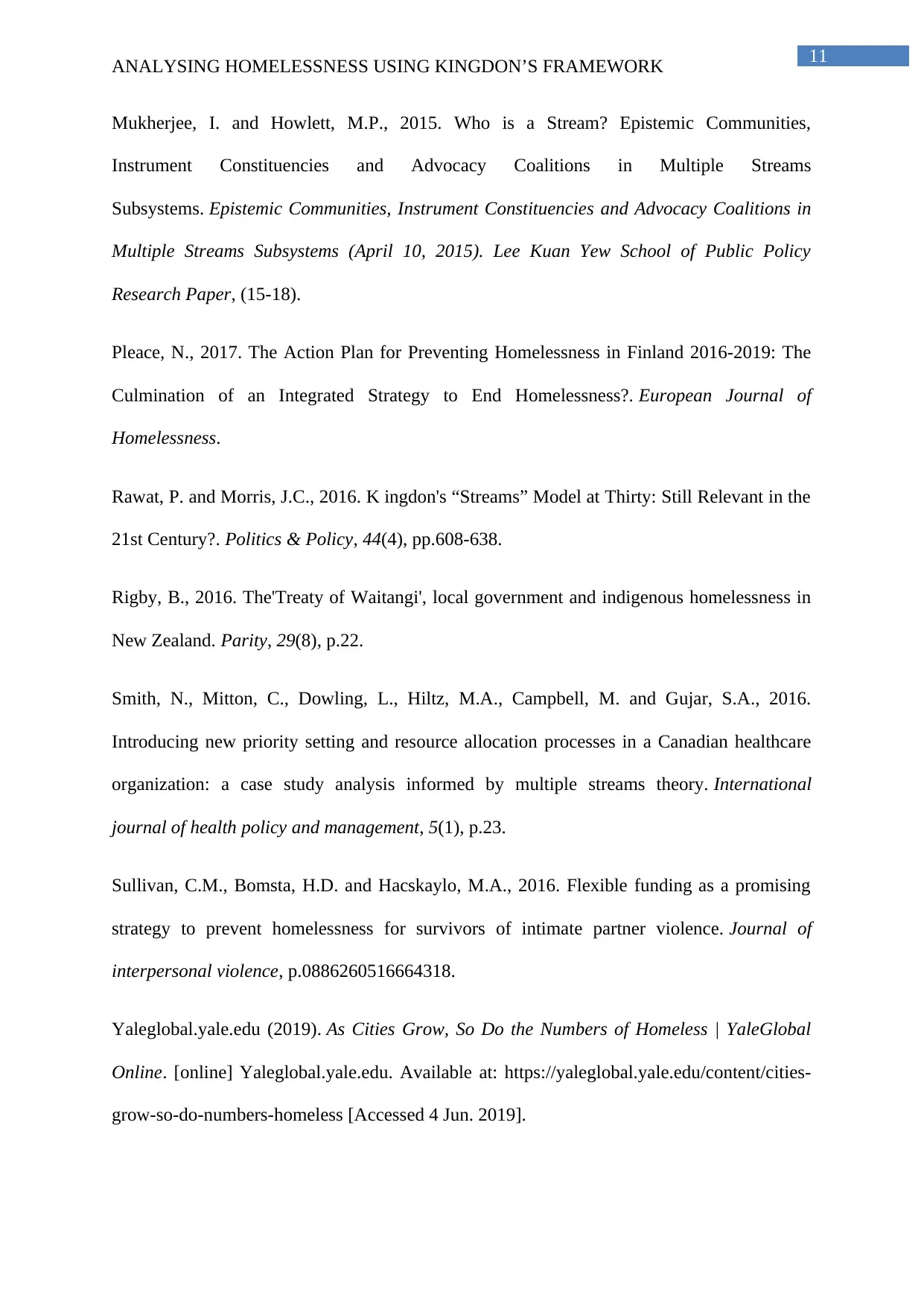
11
ANALYSING HOMELESSNESS USING KINGDON’S FRAMEWORK
Mukherjee, I. and Howlett, M.P., 2015. Who is a Stream? Epistemic Communities,
Instrument Constituencies and Advocacy Coalitions in Multiple Streams
Subsystems. Epistemic Communities, Instrument Constituencies and Advocacy Coalitions in
Multiple Streams Subsystems (April 10, 2015). Lee Kuan Yew School of Public Policy
Research Paper, (15-18).
Pleace, N., 2017. The Action Plan for Preventing Homelessness in Finland 2016-2019: The
Culmination of an Integrated Strategy to End Homelessness?. European Journal of
Homelessness.
Rawat, P. and Morris, J.C., 2016. K ingdon's “Streams” Model at Thirty: Still Relevant in the
21st Century?. Politics & Policy, 44(4), pp.608-638.
Rigby, B., 2016. The'Treaty of Waitangi', local government and indigenous homelessness in
New Zealand. Parity, 29(8), p.22.
Smith, N., Mitton, C., Dowling, L., Hiltz, M.A., Campbell, M. and Gujar, S.A., 2016.
Introducing new priority setting and resource allocation processes in a Canadian healthcare
organization: a case study analysis informed by multiple streams theory. International
journal of health policy and management, 5(1), p.23.
Sullivan, C.M., Bomsta, H.D. and Hacskaylo, M.A., 2016. Flexible funding as a promising
strategy to prevent homelessness for survivors of intimate partner violence. Journal of
interpersonal violence, p.0886260516664318.
Yaleglobal.yale.edu (2019). As Cities Grow, So Do the Numbers of Homeless | YaleGlobal
Online. [online] Yaleglobal.yale.edu. Available at: https://yaleglobal.yale.edu/content/cities-
grow-so-do-numbers-homeless [Accessed 4 Jun. 2019].
ANALYSING HOMELESSNESS USING KINGDON’S FRAMEWORK
Mukherjee, I. and Howlett, M.P., 2015. Who is a Stream? Epistemic Communities,
Instrument Constituencies and Advocacy Coalitions in Multiple Streams
Subsystems. Epistemic Communities, Instrument Constituencies and Advocacy Coalitions in
Multiple Streams Subsystems (April 10, 2015). Lee Kuan Yew School of Public Policy
Research Paper, (15-18).
Pleace, N., 2017. The Action Plan for Preventing Homelessness in Finland 2016-2019: The
Culmination of an Integrated Strategy to End Homelessness?. European Journal of
Homelessness.
Rawat, P. and Morris, J.C., 2016. K ingdon's “Streams” Model at Thirty: Still Relevant in the
21st Century?. Politics & Policy, 44(4), pp.608-638.
Rigby, B., 2016. The'Treaty of Waitangi', local government and indigenous homelessness in
New Zealand. Parity, 29(8), p.22.
Smith, N., Mitton, C., Dowling, L., Hiltz, M.A., Campbell, M. and Gujar, S.A., 2016.
Introducing new priority setting and resource allocation processes in a Canadian healthcare
organization: a case study analysis informed by multiple streams theory. International
journal of health policy and management, 5(1), p.23.
Sullivan, C.M., Bomsta, H.D. and Hacskaylo, M.A., 2016. Flexible funding as a promising
strategy to prevent homelessness for survivors of intimate partner violence. Journal of
interpersonal violence, p.0886260516664318.
Yaleglobal.yale.edu (2019). As Cities Grow, So Do the Numbers of Homeless | YaleGlobal
Online. [online] Yaleglobal.yale.edu. Available at: https://yaleglobal.yale.edu/content/cities-
grow-so-do-numbers-homeless [Accessed 4 Jun. 2019].
1 out of 12
Related Documents
Your All-in-One AI-Powered Toolkit for Academic Success.
+13062052269
info@desklib.com
Available 24*7 on WhatsApp / Email
![[object Object]](/_next/static/media/star-bottom.7253800d.svg)
Unlock your academic potential
© 2024 | Zucol Services PVT LTD | All rights reserved.





